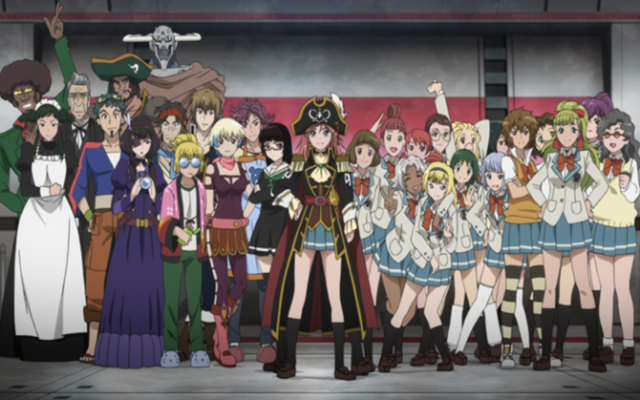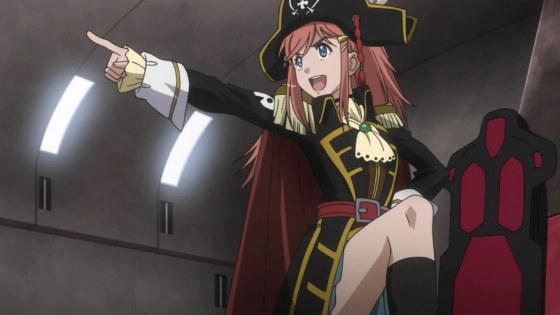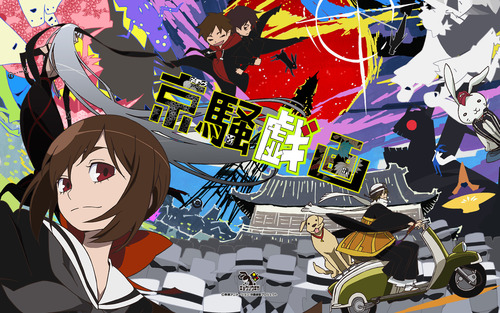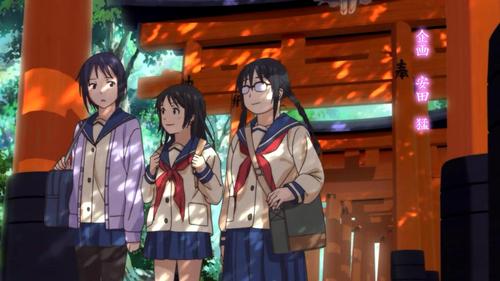Shining Seinen Part 2: Leading Ladies in Anime and Manga For Men
Space pirates, wielders of magic hammers, and shout-outs to magical girls!
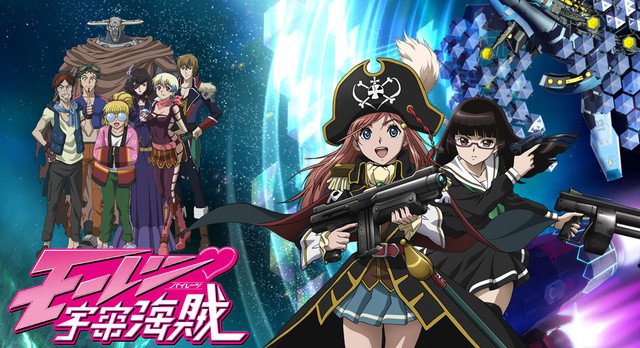
Seinen manga and anime is manga and anime that is aimed towards adult men. One might find it surprising considering the demographic, but this series will explore an interesting range of female leads—not just super action heroes, but also teenage girls embroiled in romantic drama and 19th century brides. This article hopes to show that even stories that target men can be woman-friendly and feature a range of interesting women and unique female narratives. Part one introduced you to four lady-led seinen anime/manga worth your time, but they’re far from the only ones. So let’s dig in and hopefully help you discover some new stories to consider!
Moretsu Space Pirates
Moretsu Space Pirates, alternately known as Moretsu Pirates, Bodacious Space Pirates, and Miniskirt Space Pirates, was a light novel series by Yūichi Sasamoto that started in 2008. It was adapted into an anime in 2012 with a film released in 2014. A web manga was also launched in 2012.
Moretsu follows the adventures of Marika Kato, a normal high school girl raised by a single mother who suddenly finds out her father not only recently died, but was a legal space pirate (privateer), and she is the heir to his ship and crew. Her mother, also a former space pirate, encourages her to take over. She decides to give it a shot and brings a gang of girlfriends with her.
Despite its provocative name, Moretsu is actually not very heavy on fanservice (there’s a bit of it, including skin-tight space suits and a couple of skin-baring outfits, but there’s never so much that it’s distracting—the swimsuit episode even emphasizes the guy’s Speedo-clad butt as much as it does the girls’). It’s mostly a fun and wacky sci-fi slice-of-life romp about a competent, cheerful, determined girl making her mark as a space pirate captain with her band of ladyfriends. The greatest thing is there’s a ton of female friendship, and two canonical lesbian characters get a few episodes entirely devoted to them. They are in a happy relationship and kiss onscreen, receiving support from all their friends.
There’s also a really neat little plot where a high school girl is talented enough that she’s running her own business, and her uncle is so afraid of her talent threatening his position in his company that he tries to get her in an arranged marriage to his son, but the pirates come to help her. Ladies helping other ladies to succeed in business and defy oppressive men!
There are also a couple of Indian and African-looking characters, even if they aren’t incredibly prominent. One of the characters, a blonde dumpling-head princess named Serenity, is also an obvious homage to Sailor Moon. That should give you an idea of how the series doesn’t take itself very seriously and mostly has fun with its own ridiculousness.
There’s little to warn for, so this show is definitely recommended for a fun, silly watch full of girls being awesome. TIME FOR SOME SPACE PIRACY.
Moretsu Space Pirates is available on Crunchyroll and Hulu. Sentai Filmworks released the show on DVD and digitally on iTunes; for the Blu-ray, head to Amazon.
Kyōsōgiga
Kyōsōgiga started out as web series of six episodes directed by Rie Matsumoto. The first one was the length of a normal anime episode, and the next five were 4-6 minutes in length each. In 2012 it received an ongoing manga adaptation, and in 2013 it was made into a full-length anime series that ran for 10 original episodes. The anime incorporated most of the footage from the web series into its storyline.
Kyōsōgiga describes itself as a “tale of a certain family, a tale of rebirth.” The main protagonist is Koto, a tough 14-year-old girl armed with a magic hammer. She was named for her missing mother, whom she is told she can find by following a black rabbit. Myoue, a depressed priest left to run the magical mirror city of Kyoto after his parents go missing, is surprised when Koto somehow breaks into their dimension while following the rabbit. He has an adoptive mother, also named Koto, and two adoptive siblings, a very proper but temperamental demon girl named Yase and the mystical Kurama. The whole family is tied together by the mysterious powers of Myoue’s father, whom he simply refers to as “The Priest.” Koto and Myoue must work together to uncover the secrets of their lost family and save the mirror dimension from destruction.
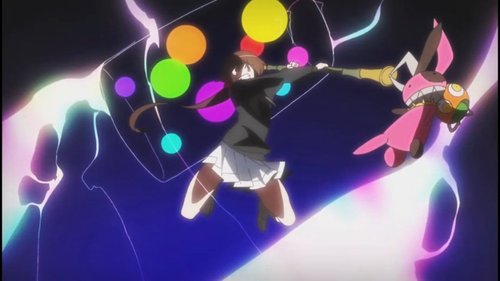
Kyōsōgiga is a bizarre and very complex story, and one that’s ultimately rewarding and often touching. It is very steeped in Japanese mythology, history, and culture (Myoue is named after a historical monk, for instance) but is still accessible to someone without much knowledge of those subjects. In fact, it’s likely to help the viewer learn a few things. There’s even a bonus live-action episode where the voice actors tour all the places that the setting of Kyōsōgiga was inspired by.
The narrative starts out somewhat non-linear, though by episode 3 the viewer pretty much gets most of the backstory and the basics of what’s going on. I would advise watching the anime series rather than the original 6-episode web series—nearly all that footage is incorporated into the anime series anyway, and it gives additional context and finishes the story. I would also advise either skipping episode 0 of the anime entirely or watching it after you finish the series. It’s just the first web series episode re-aired, and since nearly everything in it happens later on in the anime, watching it first can be confusing and is likely to put you off the series.
Kyōsōgiga is, at its core, about a family of very different people trying to patch themselves back together. It takes place in a colorful, fantastical world full of equally colorful characters with godlike powers. Koto is a powerful, determined girl who kicks a lot of butt and has a sense of whimsy and a can-do attitude about her, but she’s also a kid just trying her best—she has a difficulty shouldering everything and makes mistakes that she has to drag herself back from. Her emotional arc, her decisions, her steadfast desire to save her loved ones—they are what hold everything together. In addition to Koto, there are lots of other dynamic female characters. The demon woman Yase’s relationship with her mother and her sisterly relationship with Koto gets an episode’s focus, and Koto’s relationship with her mother is important to the anime as well.
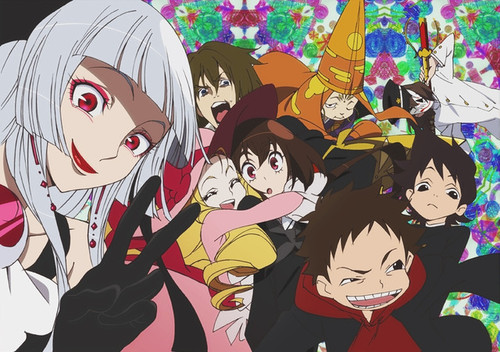
The story also deals with fairly dark themes, like suicidal feelings and what is almost definitely depression in one of the characters. Coping with loss and trying to rebuild is a big theme in the series, as is dealing with abandonment and wanting to erase yourself out of guilt. As someone who’s dealt with a lot of that stuff, I feel it’s handled well for the most part—the narrative makes it clear those feelings are not ones that go away easily. Despite being a short series, Kyōsōgiga managed to have a satisfying narrative that holds together very well and works on multiple levels, especially thematically. The main characters generally feel well rounded and complex.
As noted above, the series depicts depression and suicidal feelings, a child attempting to commit suicide in a very violent matter (and sort of succeeding—it’s complicated), and also dead bodies. There’s also the fact that this godlike family tends to settle their disputes in knock-out, drag-down superpowered fights, as befitting the zany and larger-than-life aspects of the series. There is very little in the way of sexualization of female characters and fanservice, though, which is nice.
Kyōsōgiga is available on Crunchyroll.
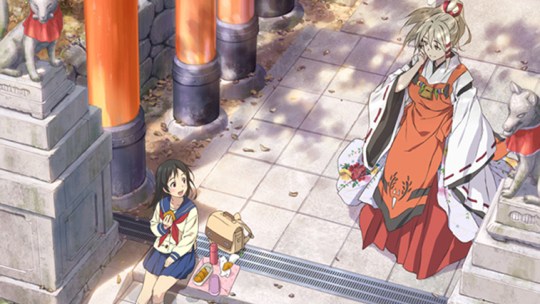
Inari, KonKon, Koi Iroha
Inari, KonKon, Koi Iroha also known as Inari, KonKon, ABCs of Love or InaKon for short, is an ongoing manga by Morohe Yoshida that started in 2010. There was an 11-episode anime released this year.
InaKon follows a very insecure young girl named Inari. After humiliating the boy she has a crush on, her already fragile self-confidence plummets, and she finds herself wishing she could turn into someone whom she and her crush could better admire. She ends up meeting a goddess named Uka who presides over the local shrine. Since Inari rescued one of Uka’s familiars, Uka grants her wish, but it has unforeseen consequences. The story after that focuses on Inari dealing with her powers and her relationship with the goddess.
InaKon is at its core a story about Inari struggling with her self-worth and learning to have confidence in herself, which is always nice to see. In addition, a great deal of the show is focused on Uka and Inari’s relationship and their desire to understand and protect each other. The story actually focuses on a lot of really supportive relationships between women—all of Inari’s ladyfriends are really developed, with their own character arcs and conflicts, and their various relationships with each other are extremely important to the series. InaKon is actually so dedicated to relationships between women that it actively subverts the common love triangle trope of two girls fighting over a boy, offering sly meta commentary at the same time.
The story also features a main supporting character who has feelings for another girl. She is treated respectfully, and her friends are supportive when she comes out to them. Her story isn’t really resolved in the anime, and prospects aren’t looking great in the manga for her right now (though that could change), but her feelings are shown to be legitimate. Romance is also a big theme, with Inari and Uka having crushes/male love interests.
There are some things that might be rough—one of the characters falls into “comedic sexual harasser” territory, though unlike most anime examples he is never successful in actually physically harassing or spying on anyone—he is either stopped by women beating the crap out of him before he can touch them or foiled in some other way. He also has an incestuous crush on his sister, though she absolutely despises him for it and for his general behavior, as does everyone else. Another uncomfortable part is when Uka’s love interest goes off on a sexist rant during an argument. He yells that he doesn’t think Uka’s breasts are real, so maybe he should check them. He acts ashamed, and she’s horrified enough about a lot of what he says to ditch him for it. Whether or not his behavior is condoned, it can still be an uncomfortable scene to watch. There’s also an instance early on in the manga of him touching her breasts while she sleeps, though fortunately this is cut from the anime. There are a few gender essentialist comments as well.
But if you can handle that, this is a very cute and warm story. Though it is seinen, it’s clear a lot of inspiration was take from slice-of-life shoujo stories, with magical girl stories as another obvious reference. It is overall a very positive experience.
The Inari KonKon Koi Iroha anime is available at Funimation’s website and Hulu. The manga, unfortunately, has not yet been licensed.
Caitlin Donovan is a longtime comic geek and internet blogger who is currently working on her MFA and her first novel. She formerly wrote for Big Shiny Robot and for a time helped run the blog When Fangirls Attack. These days, she mostly can be found blogging on her Tumblr, Lady Love and Justice.
Are you following The Mary Sue on Twitter, Facebook, Tumblr, Pinterest, & Google +?
Have a tip we should know? [email protected]
